Sharks may star in the bloodiest blockbusters and spiders tend to monopolise the phobia department, but when you get down to the facts, neither of these creatures are even close to being the scariest to stalk the planet. Indeed, there are many ferocious beasts, both large and small, that are downright deadly. Here, the 10 most dangerous animals in the world.
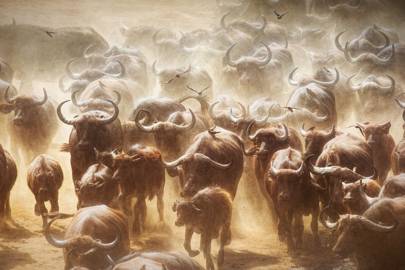
10. CAPE BUFFALO
Cape buffaloes, which number around 900,000 and are found in sub-Saharan Africa, are a relatively mild species when left alone, preferring to travel in massive herds to graze in early-morning and late-afternoon hours or to gather around watering holes to stay hydrated. However, if one (or its calf) is threatened or wounded, it becomes the incarnation of its nickname: black death. Reportedly responsible for killing more hunters on the continent than any other creature, these behemoths, which can grow up to nearly 6ft tall and weigh close to 2,000lb, circle and stalk their prey before charging at speeds of up to 35 miles per hour. They’re also known to continue charging if they’re injured, and will not hesitate to attack moving vehicles. You don’t want to mess with those horns.
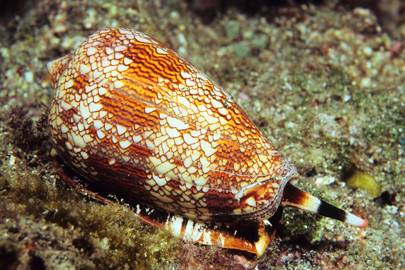
9. CONE SNAIL
Found in the warm waters of the tropics (the Caribbean, Hawaii and Indonesia), these beautiful creatures, instantly recognisable for their highly prized, brown-and-white marbled shells, can be seen in shallow depths closer to shore, near coral reefs and rock formations and beneath sandy shoals. But do not dare to touch the gastropods, which can be up to six inches long: their concealed, harpoon-like ‘teeth’ contain a complex venom known as a conotoxin, making them one of the most poisonous species of snails. If you suffer the unlucky fate of becoming one of the handful of people ever stung, head to the hospital immediately, as there is no antivenom. The toxin stops nerve cells from communicating with one another, so the creature not only causes paralysis within moments, but, given its nickname of cigarette snail, affords you about enough time to smoke one before you die.
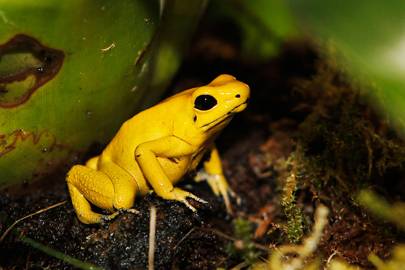
8. GOLDEN POISON DART FROG
The poison dart is the name of a large, diverse group of brightly coloured frogs that live mostly in northern South America, of which only a handful of species are particularly dangerous to humans. The most deadly, the golden poison dart, inhabits the small range of rainforests along Colombia’s Pacific coast, and grows to around two-inches long (roughly the size of a paper clip). Its poison, called batrachotoxin, is so potent that there’s enough in one frog to kill 10 grown men, and just two micrograms is enough to kill a single individual. But what makes the amphibian especially dangerous is that its poison glands are located beneath its skin, meaning a mere touch will cause trouble. It’s little wonder the indigenous Emberá people have laced the tips of their blow darts used for hunting with the frog’s toxin for centuries. Sadly, deforestation has landed the frog on several endangered lists, but even if you do have a rare sighting when hiking, don’t go reaching for it.
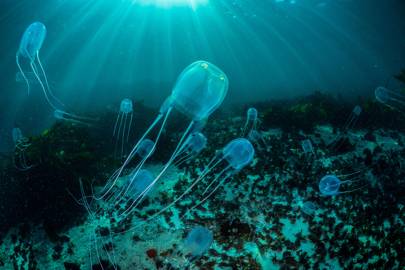
7. BOX JELLYFISH
Often found floating (or moving at speeds close to five miles per hour) in the Indo-Pacific waters north of Australia, these transparent, nearly invisible invertebrates are considered by the National Oceanic and Atmospheric Administration to be the most venomous marine animal in the world. Their namesake cubic frames contain up to 15 tentacles at the corners, with each growing as long as 10ft, all lined with thousands of stinging cells – known as nematocysts – which contain toxins that simultaneously attack the heart, nervous system, and skin cells. While antivenins do exist, the poison is so powerful that many of the hundreds of reported victims each year go into shock, drowning or dying of heart failure before reaching shore. Even if you are lucky enough to make it to the hospital and receive the antidote, survivors can sometimes experience considerable pain for weeks afterwards and bear nasty scars from the creature’s tentacles.
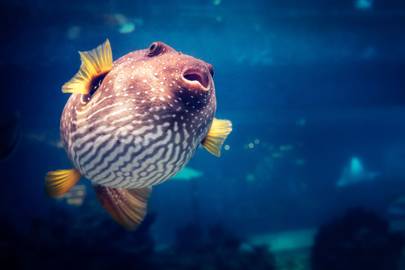
6. PUFFERFISH
Pufferfish, also known as blowfish, are located in tropical seas around the globe, especially around Japan, China and the Philippines. Though they’re the second most poisonous vertebrate on the planet (after the golden arrow dart frog), they’re arguably more dangerous as their neurotoxin, called tetrodoxin, is found in the fish’s skin, muscle tissue, liver, kidneys and gonads – all of which must be avoided when preparing it for human consumption. Indeed, while wild encounters are certainly dangerous, the risk of death from a pufferfish increases when eating it in countries such as Japan, where it is considered a delicacy known as fugu and can only be prepared by trained, licensed chefs. Even then, accidental deaths from ingestion occur several times every year. The tetrodotoxin is up to 1,200 times more poisonous than cyanide, and can cause deadening of the tongue and lips, dizziness, vomiting, arrhythmia, difficulty breathing, muscle paralysis and, if left untreated, death.
5. BLACK MAMBA
Though species such as the boomslang or king cobra are dangerous as a result of their poisons, the black mamba is especially deadly due to its speed. Found in the savannas and rocky areas of southern and eastern Africa, the species (which can grow up to 14ft long) is the fastest of all snakes, slithering at speeds of up to 12.5 miles per hour, which makes escaping one in remote areas that much more difficult. Thankfully, black mambas usually only strike when threatened – but when they do, they’ll bite repeatedly, delivering enough venom (a blend of neuro- and cardiotoxins) in a single bite to kill ten people. And if one doesn’t receive the correlative antivenin within 20 minutes, the bites are almost 100 per cent fatal.

3. TSETSE FLY
Often regarded as the world’s most dangerous fly, the tsetse – a small speck of an insect that measures up to 0.7 inches, or about the same size as the average house fly – is commonly found in sub-Saharan countries, especially those in the center of the continent including the Sudans, the Democratic Republic of the Congo and Angola. While the flies themselves are nasty bloodsucking bugs that usually feed during the peak warm hours, their true terror lies in the protozoan parasites they spread known as trypanosomes. These microscopic pathogens are the causative agent of African sleeping sickness, a disease marked by neurological and meningoencephalitic symptoms including behavioural changes and poor coordination, as well as the disturbances to the sleep cycle that give the illness its name. If left untreated, it can lead to death. While there are no vaccines or medications available to prevent infection, methods of protection include opting for neutral-coloured clothing (the tsetse is attracted to bright and dark shades, especially blue), avoiding bushes during the day and wearing permethrin-treated gear in more remote areas.

1. HUMANS
Surprised? We’re animals, too, after all. And seeing as we’ve been killing each other for 10,000 years, with the total deaths resulting from war alone estimated at between 150 million and one billion, it’s a no-brainer that we top the list. Though we are said to be living in the most peaceful period now than at any other time in our history, we still assault each other with incredibly high rates of senseless brutality, from gun violence in cities such as Munich and Florida’s Fort Lauderdale to terrorist attacks around the globe. We’re dangerous to other animals, too – think global warming and the destruction of forests and coral reefs. Given the threat we pose to countless other creatures – and the fact that we often act irrationally and have the capacity to annihilate our entire planet with a host of horrifying weapons – we are easily number one on the list of the most dangerous animals in the world.
Credit: Source link